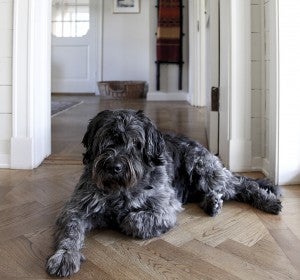 Separation Anxiety is very common in dogs. When dogs are left alone they suffer with severe panic symptoms and become so distressed showing destructive behavior such as howling, barking, licking and chewing themselves which causes physical harm to their bodies. Becoming a dog owner is an important step to take. Teaching your dog as a puppy a balance of becoming independent to be left alone for certain amounts of time and for you to be a good companion to your dog should be a priority.
Separation Anxiety is very common in dogs. When dogs are left alone they suffer with severe panic symptoms and become so distressed showing destructive behavior such as howling, barking, licking and chewing themselves which causes physical harm to their bodies. Becoming a dog owner is an important step to take. Teaching your dog as a puppy a balance of becoming independent to be left alone for certain amounts of time and for you to be a good companion to your dog should be a priority.
1- Tolerate Staying Alone – As you teach your dog to stay alone you should start with short amounts of time for a few days so you will be able to see if there is any sign of anxiety then gradually add more time. Short intervals will help your dog not have a setback and get anxious and accept this as a normal part of life. Learning that you are the pack leader and you make the decisions, your dog will then be confident that you will return.
2- Independence and Self Assurance – Dogs need to learn to balance solitude, companionship and to respect their pack leader. Learning to survive by himself, teach your dog not to follow you around by telling him “Down” and “Stay.” If you are watching television or talking on the phone, tell him “Down” on his blanket and “Stay.” When you are ready to interact with him reward him by playing with his favorite toy.
3- Leaving and Coming Home Showing No Excitement – The best thing to do for your dog is to make leaving and returning a very uneventful time. No emotional “Good bye” or “Hello, I missed you.” It would greatly benefit your dog if you avoid eye contact and say nothing and completely ignore him for up to twenty minutes before your leave and upon your return home. Your dog should be calm then you can let him come out of his safe location, and while you stay calm praise and pet him quietly. If there are any signs of being anxious, continue ignoring him until he is fully relaxed and calm.
4- Safe Environment – Choose a room that is well lit, safe, comforting and has familiar family smells such as a family room or a kitchen for your dog’s home alone place. Use a strong baby gate if there is no door to block the entrance. Safety proof the room by keeping plants out of reach, latch cabinets, and keep windows closed as dogs can tear through screens and jump through opened windows. Remove items that your dog would destroy such as collectables, baskets, shoes and tablecloths so they are not tempted to chew.
5- Mental and Physical Stimulation – A continuous playing CD with calm music, classical music or sounds of the ocean with quiet music in the background is great to keep your dog calm. Play the music when you are home so your dog is familiar with it and will relax while you are away. Stimulating and safe toys are a must to keep him content and occupy his day. Chew toys that are safe, and of course his favorite toys that he loves will comfort him and make his day more enjoyable. There are Kong-type toys that are hollow and can be stuffed with treats such as carrots, and kibbles that will keep your dog occupied for a long time, and Buster Cube and Kong can feed your dog his complete meal.
Time and patience to overcome anxiety with your dog along with security in their environment, and having confidence in you and themselves will make your dog stress free and give him a well balanced life.
Photo credit: Espen Faugstad/Flickr

















